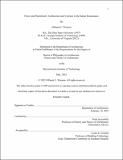Power and Punishment: Architecture and Violence in the Italian Renaissance
Author(s)
Winston, ElDanté C.
DownloadThesis PDF (14.14Mb)
Advisor
Jarzombek, Mark
Terms of use
Metadata
Show full item recordAbstract
The traditional narrative of a humanistic Renaissance, with its tropes of classical ornament, courtly manners, and artistic geniuses, has clouded the study of Italian Renaissance architecture. Over the course of three chapters, this dissertation challenges this narrative, reexamining the city, architecture, and architectural spaces across the complex milieu of the fifteenth and sixteenth century, starting with the concept of the ‘ideal’ city. The most truthful prescription of the paragon city is found in the combined text and images of military architectural treatises with their geometrically defined city walls. Reflective of its chaotic time, it is a paragon city under the jurisdiction of a ruler whose primary authority is the right to judge and dispense punishment. Because of the authoritarian overtone, the military architectural treatise has not been given the same consideration as its civic counterpart. The marginalization of military architecture has resulted in the exclusion of certain types of buildings from the history of Italian Renaissance architecture. The rocche and castles built during the Renaissance, misclassified as military architecture, have an underlying medieval heritage that has resulted in their omission from the broader discourse of Italian Renaissance architecture. Though fortified, these structures are no different from the classically clothed villas of the wealthy, more commonly examined and discussed. The conventional focus on patronage and magnificence excludes the actual sociopolitical environment, one of power, violence, justice, and execution—each regularly on display in the main piazzas of Italian cities. Violent threats to those in power demanded swift punishment that often resulted in the public execution of the offender. The public space of the piazza is understood as a space of authority and control: a gateway to power where certain kinds of violence were deemed acceptable. The exclusion of violence from Renaissance architectural history promotes a bias inherent in the traditional narrative. The resolution is a more inclusive narrative, one that acknowledges that the Renaissance is more complex and complicated than ideal.
Date issued
2022-05Department
Massachusetts Institute of Technology. Department of ArchitecturePublisher
Massachusetts Institute of Technology